
History of the Warrior Markers
Little Bighorn Battlefield National
Monument
By Bob Reece
January 24, 2008
Note: The purpose of this article is to provide
an overview of the history of the warrior markers to date. I sincerely
thank battlefield Chief Historian John Doerner, Neil Mangum, and Jerome Greene
for answering many questions during the writing of this article. This article
also appeared in the newsletter of the Custer Association of Great Britian.
As soldiers marched north beside the
Little Bighorn River and from the valley of death, they looked up into the tall
cottonwood trees. Resting high up were remains of Lakota warriors who fell
fighting George Armstrong Custer and the 7th Cavalry three and four days before.
The stench of death followed these
soldiers which they could not get away from fast enough. From near the area of
present-day Crow Agency, Montana, a soldier could look over his right shoulder
and see light reflecting from debris still left on the ground where Custer’s
soldiers fell. Left behind were many of these soldiers’ friends, unidentified
and in the hands of predators. Some may have felt reassured that identified
officers’ graves were marked with wooden stakes. The dead private in Custer’s
battalion was not so fortunate; his resting place was not marked with such
stakes. For a more detailed study of the history of the burials and reburials of
the Custer dead please refer to the article,
“Dust to
Dust: Interment of the Custer Dead” published on this website.
The Indians managed their dead after
the Battle of the Little Bighorn in a completely different way. Most, if not
all, of the dead were identifiable. All wounded and dead warriors were taken
from the battlefield by loved ones, family, or friends. They remembered where
their loved one fell by marking the spot with a rock cairn. There are no names
etched on these cairns, but the family never forgot.
Because the Custer Battlefield is
mostly sandy soil with pebbles at best, any rock cairn or evidence of one is
still visible after all these years, if you can find it through the tall grass.
I have been fortunate to view nearly a dozen cairns over the years at Custer’s
and Reno-Benteen’s Battlefields. As you walk the battlefield, you will notice
how uncannily the cairns suddenly appear through the tall grass, as if a ship is
sailing silently toward you in the fog. It is difficult to find words to
describe what I felt while gazing upon a very powerful memorial. It is far
easier to share what I was thinking: was the warrior that fell near here Lakota
or Cheyenne? Was he young or old? What was his name?
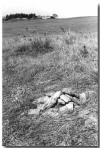
Lame White Man rock cairn
photo courtesy Little Bighorn Battlefield
National Monument
First Warrior Marker
The first known request for a
warrior marker was in 1925 from the daughter of Lame White Man. Jerome Greene in
his book
Stricken Field: The Little Bighorn Since 1876 states on
page 170: “Mrs. Thomas Beaverheart, a Northern Cheyenne, wrote Superintendent
Wessinger asking that a marker be placed on the battlefield to indicate the spot
where her father, Lame White Man, had fallen in battle, her request drew no
response.” The U.S. War Department managed the battlefield in 1925. Any chances
for a warrior marker remained dormant for another 30 years.
Prospects for warrior markers
finally blossomed in the 1950s thanks to the unselfish work of past chief
historian, Don Rickey Jr., at then Custer Battlefield National Monument, and
Cheyenne oral historian John Stands In Timber. Together, Rickey and Stands In
Timber walked over the battlefield. Stands in Timber showed Rickey the cairns
and matched as many as he could with a warrior’s name. Stands In Timber spent
time with warriors who fought in the Custer fight and heard their battle
accounts, as well as those who died there first-hand.
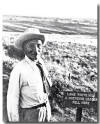
John Stands In Timber beside first Lame
White Man marker, ca 1958 --
photo courtesy Little Bighorn
Battlefield and Dr. Margot Liberty
The result of this
diligent work was Rickey placing the first wooden warrior marker on the field in
1958. It memorialized Lame White Man. What I am about to share with you was told
to me by a park ranger in the 1980s. There is no written documentation to
support it, but it is an interesting story nevertheless: Rickey placed Lame
White Man’s marker on the field very near where he fell. It read: “Lame White
Man, a Cheyenne leader fell here.” Soon, visitors began to complain that they
could not see the marker from the road. Rickey decided to create a new marker
for Lame White Man and placed it on the shoulder of the road where it remained
until Lame White Man’s granite marker was placed on the field 41 years later.
The new marker along the road stated: “Lame White Man, a Cheyenne leader fell
near here.” Now, visitors could drive by, and without getting out of their cars,
see the first marker for an Indian about whom they knew nothing.

Lame White Man's second wooden marker -- photo
© Bob Reece,
October 1983

I took this photo of Pohanka (right)
with his friend, John, at Lame White Man rock cairn in June 1985
More Rock Cairns,
No Markers: A New Generation Saves the Day
Nothing about the warrior markers changed, none were added, and no more work was
done (that I am aware of) over the next 25 years to improve on Rickey’s and
Stands In Timber’s efforts. I sometimes wonder how many visitors thought only
one warrior died fighting all of Custer’s men.
Things began to
change for the better in the mid 1980s. Tim Bernardis worked as an interpreter
during the summers, and he was passionate about finding out who
the warriors were that died in the battle; most significantly he wanted to
associate a warriors’ name with many of the cairns.
During the summer
of 1985 while I worked as an interpreter, Mr. Bernardis took me on a field trip
to Reno-Benteen Battlefield. I will never forget that day. I followed Mr.
Bernardis through the tall grass; we walked slowly and then the cairns started
to become visible. Standing about one foot tall were round rock cairns
throughout the battlefield, and I could finally see them. Today, there are
approximately 20 rock cairns with the vast majority on the Reno-Benteen
Battlefield.
It was Mr. Bernardis’
desire that marble markers with warriors’ names be placed on the field. Neil
Mangum was chief historian and chief of interpretation during this period. Mr.
Mangum appreciated the idea of marble markers for warriors, and he regarded the
work Mr. Bernardis was conducting on his own time worthwhile, but Mr. Mangum was
adamant and tough when it came to substantiating which warrior belonged with
what cairn. He did not, in his own words, “want to place markers just to put
them up” on the field. There had to be physical evidence, such as rock cairns
and documentary written evidence such as Rickey and Stands In Timber’s work.
Plus, making changes to the battlefield - especially by adding new warrior
markers - could be challenged from outside sources such as SHPO (Montana State
Historic Preservation Office). Mr. Mangum would ensure the NPS followed strict,
due diligence before the first marker ever was unveiled.
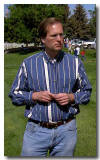
Tim Bernardis, 2003
It was during this
same period that the lead scientists provided conclusions from the various
studies of archeological digs of 1984 and 1985 to the National Park Service.
Portions of the research involved some of the soldier markers along the Deep
Ravine Trail. These spurious markers sparked a far-fetched idea in Mr. Mangum’s
quick thinking mind. The archeologists suggested some of the soldier markers
should not be on the field. When soldiers placed the white marble markers in
1890, two were placed beside each other because it was believed that two bodies
had been buried there. In some cases, the grave only held one body. Mr. Mangum
hoped to remove the extra markers from the Deep Ravine Trail. He had the support
of his superintendent, but the idea was disregarded by SHPO because it considers
the markers from 1890 to be part of the historical and cultural landscape of the
battlefield and therefore should not be tampered with. The NPS listens to and
respects any state historical preservation office and, although it does not need
to follow every suggestion given by such offices, it did in this case.
All chances for
warrior markers were feared lost when Mr. Mangum left the battlefield for a new
position with the NPS in Santa Fe, New Mexico. Maybe it was not the right time
to start adding warrior markers to the field.
A New Chief Historian, a New Superintendent, an Indian
Memorial, and Two New Warrior Markers
Four significant
events happened during the late 1980s and throughout the 1990s that finally set
the wheels in motion to change the landscape of the Custer Battlefield forever:
1) Two American Indians would manage the battlefield for the first time: Barbara
Booher (July 1989 – February 1993) and Gerard Baker (September 1993 – January
1998). 2) In 1991, Congress passed a bill and President George H. W. Bush signed
it into law to change the name of the battlefield from Custer Battlefield
National Monument to Little Bighorn Battlefield National Monument. This same law
ordered that a memorial to the Indians that fought and died at the battle should
be built. 3) John Doerner was promoted to chief historian. 4) Neil Mangum
returned to the battlefield as superintendent (March 1998 – July 2002).
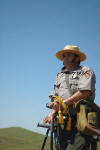
Chief Historian John Doerner, 2007
These events are
significant because for the first time, and under the leadership of Booher and
Baker, the NPS began to build a trusting relationship with the Indian community
including the Crow, Lakota, and Cheyenne. The promise of an Indian Memorial was
icing on the cake. It was also Mr. Doerner’s dream to see warrior markers on the
field, and as chief historian he had the resources to conduct the proper
research.
When Mr. Mangum
became superintendent the first thing he considered was what was most needed at
the battlefield, “to make the visitor experience more complete.” Mr. Mangum
continued to build the trusting relationship that Booher and Baker started with
the various Indian tribes and he did so very successfully. There are no American
Indians that I know of personally, or that I have heard about, that do not speak
highly of Mr. Mangum.
Mr. Mangum
remembers very well what the future Friends Vice President, Clifford Longsioux
Eaglefeathers said to him: whenever Mr. Eaglefeathers drove by the battlefield
along Hwy 212, he would look at the battlefield, but never had a desire to stop
there because there was nothing to honor the Cheyenne people. This affected Mr.
Mangum deeply. He had always understood that memorials to Indians were sorely
needed, but now it became very personal for him to do something about it.
Lame White Man
and Noisy Walking
Meantime, Mr. Doerner approached Mr. Mangum with his concept for warrior
markers. Mr. Mangum was desperately trying to find the funds needed to build the
Indian Memorial. He was becoming concerned that the memorial would not be built
at all; however individual warrior markers could be an ideal memorial for the
American Indian warrior as well as enhance interpretation. Such markers could be
placed quickly and inexpensively, and Mr. Mangum believed they could also move
the battlefield in the right direction “to make the visitor’s experience more
complete.”
Mr. Doerner
realized that his dreams of seeing warrior markers materialize would finally
come true, so he began the research wholeheartedly with assistance from Chief of
Interpretation Ken Woody. Mr. Mangum and Mr. Doerner chose Lame White Man and
Noisy Walking as their first candidates because a lot of the work had already
been conducted by Rickey and Stands In Timber. It was a wise decision.
Mr. Mangum also
appointed Mr. Eaglefeathers, Logan Curley, and Dolan Many Bad Horses as
representatives of the Cheyenne tribes because there were no family members of
the two warriors of whom anyone knew. They worked with Mr. Doerner and the
Cheyenne tribal authorities on the design and wording of the markers. Mr.
Eaglefeathers translated the English names into their proper Cheyenne spelling,
as can be seen on the markers today. Mr. Mangum wanted
the warrior markers to stand out from the soldiers’ white stark markers so he
chose red granite so they could be more easily found.
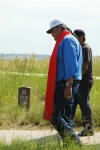
Friends V.P. Clifford Longsioux
Eaglefeathers, 2005
After all the work
was compiled, Mr. Mangum sent a letter to SHPO advising them of his intentions.
He was pleased when they approved. Finally, after 123 years during a small
ceremony on Memorial Day, May 31, 1999, Mr. Mangum and Mr. Doerner unveiled the
very first red granite markers for Indian warriors who fell in the Battle of the
Little Bighorn. Memorial Day is a U.S. holiday that honors the men and women who
died fighting for our country. Because countless American Indians have died for
and continue to defend our country to this day, Mr. Mangum could not think of a
better date. The whole event was small and private.
After the markers
were unveiled, Mr. Eaglefeathers said something to Neil that still gives him
goose bumps: He said that his people “now have a reason to stop” at the
battlefield. It is a fact that American Indian visitation has increased
dramatically since then, and even more so since the Indian Memorial dedication.
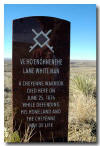
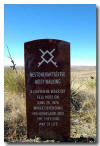
Lame White Man & Noisy Walking
A Prayer for Long
Road
The next marker
was dedicated June 26, 2001 for Sans Arc Lakota, Long Road. He died fighting
against Benteen’s men, so his marker was the first at Reno-Benteen Battlefield.
This was a much more public unveiling since it corresponded with the NPS
commemorating the 125th anniversary of the battle. Mr. Mangum had a Lakota
tribal member scheduled to recite a prayer, but this person never showed up. Mr.
Mangum was standing before many visitors waiting for the unveiling to begin. In
desperation, Mr. Mangum asked if there was an American Indian in the crowd who
would feel comfortable saying a prayer for Long Road. George Roybal, Assiniboine/
Dakota from Fort Peck Indian Reservation stepped out from the crowd and offered
his services. He gave a powerful and emotional prayer that stunned the crowd.
There were many tears among the faces in the audience.
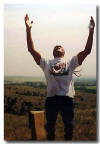
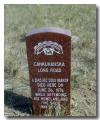
George Roybal,
2001 Long Road,
2001
photo courtesy Little Bighorn Battlefield
Future Warrior
Markers
There is sometimes
debate about whether the land that the Battle of the Little Bighorn was fought
upon was Cheyenne or Crow land at the time. Needless to say, after Long Road’s
marker was placed, the NPS changed the wording on all future markers to read,
“O’Xasehe, Cut Belly [example], a Cheyenne warrior died here on June 25, 1876
while defending the Cheyenne way of life.”
The current
superintendent, Kate Hammond, and Mr. Doerner continue the difficult work of
researching future warrior makers. In a December 28, 2007 email, Mr. Doerner
wrote, "I have been working very hard on future markers including the white
man-mixed blood killed in action atop Sharp Shooter Ridge, so hopefully his can
be next.”
Friends of the
Little Bighorn Battlefield has helped fund some of the warrior markers. If I
may, I would like to thank its membership, including those in the Custer
Association of Great Britain, who helped us succeed in assisting the NPS with
these markers. You can see a list of other projects
with which we have assisted the NPS.
List of Warrior
Markers and Their Numbers To Date:
#300. Lame White Man, Southern
Cheyenne (1999) CUST
#301. Noisy Walking, Northern Cheyenne (1999) CUST
#302. Long Road, Sans Arc Lakota (2001) RB
#303. Dog’s Backbone, Minnikojou Lakota (2003) RB
#304. Unknown Lakota with Headdress (2003) CUST
#305. Closed Hand, Northern Cheyenne (2005) CUST
#306. Cut Belly, Northern Cheyenne (2005) CUST)
#307. Little Whirlwind, Northern Cheyenne (2005) RB
#308. Limber Bones, Northern Cheyenne (2005) CUST
#309. Black White Man, Minnikojou Lakota (2006) CUST
#310. Bear With Horns, Hunkpapa Lakota (2006) CUST
#311. Breech Cloth, Minnikojou Lakota (2006) RB
#312. Elk Stands On Top, Sans Arc Lakota (2006) RB
#313. Swift Bear, Hunkpapa Lakota (2006) RB
#314. Hawk Man, Hunkpapa Lakota (2006) RB
#315. Two Bear, Sans Arc Lakota (2006) RB
#316. White Eagle, Minnikojou Lakota (2006) RB
#261. Bloody Knife (2007) RB
#262. Sgt. Bobtail Bull (2007) RB
#263. Little Brave (2007) RB
#317 Roman Nose (2008) RB
"History of the Warrior Markers -- Little Bighorn Battlefield National
Monument" © Bob Reece, 2008
(Back
to Top)
|










